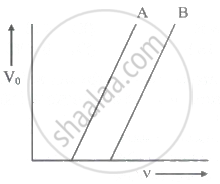Advertisements
Advertisements
Question
Radiation of wavelength 4500 Å is incident on a metal having work function 2.0 eV. Due to the presence of a magnetic field B, the most energetic photoelectrons emitted in a direction perpendicular to the field move along a circular path of radius 20 cm. What is the value of the magnetic field B?
Solution
Data: λ = 4500 Å = 4.5 × 10-7 m,
Φ = 2.0 eV = 2 × 1.6 × 10-19 J = 3.2 × 10-19 J
h = 6.63 × 10-34 J.s, c = 3 × 108 m/s,
r = 20 cm = 0.2 m, e = 1.6 × 10-19 C, m = 9.1 × 10-31 kg
`1/2 "mv"_"max"^2 ("KE"_"max") = "hc"/lambda -* phi`
`= ((6.63 xx 10^-34)(3 xx 10^8))/(4.5 xx 10^-7) - 3.2 xx 10^-19`
= 4.42 × 10-19 - 3.2 × 10-19
= 1.22 × 10-19 J
∴ `"v"_"max" = sqrt(2/"m" "KE"_"max") = sqrt((2 xx 1.22 xx 10^-19)/(9.1 xx 10^-31))`
`= sqrt(0.2681 xx 10^12) = 5.178 xx 10^5` m/s
Now, centripetal force, `("mv"_"max"^2)/"r"` = magnetic force, Bevmax
∴ B = `("mv"_"max")/"re" = ((9.1 xx 10^-31)(5.178 xx 10^5))/((0.2)(1.6 xx 10^-19))`
= 1.472 × 10-5 T
APPEARS IN
RELATED QUESTIONS
Explain the inverse linear dependence of stopping potential on the incident wavelength in a photoelectric effect experiment.
Find the energy of photon which have momentum 2 × 10-16 gm-cm/sec.
If the total energy of radiation of frequency 1014 Hz is 6.63 J, Calculate the number of photons in the radiation.
What is the photoelectric effect? Define stopping potential and photoelectric work function.
The energy of the incident photon on the metal surface is 3 W and then 5 W, where W is the work function for that metal. The ratio of velocities of emitted photoelectrons is ______.
The maximum velocity of photoelectron emitted is 4.8 m/s. If the e/m ratio of the electron is 1.76 × 1011 C/kg, then stopping potential is given by ______
The ratio of energies of photons produced due to transition of electron of hydrogen atom from its (i) second to first energy level and (ii) highest energy level to second level is respectively.
The following graph shows the stopping potential V0 versus frequency v for photoelectric emission from two metals A and B. The slope of each of the lines gives ______

When a photon enters glass from air, which one of the following quantity does not change?
Threshold frequency for a metal is 1015 Hz. Light of `lambda` = 4000 Å falls on its surface. Which of the following statements is correct?
Photoelectrons emitted from a metallic surface are initially ____________.
The threshold frequency for a certain photosensitive metal is v0. When it is illuminated by light of frequency v = 2v0, the maximum velocity of photoelectrons is v0. What will be the maximum velocity of the photoelectrons when the same metal is illuminated by light of frequency
v = 5v0?
In photoelectric effect, graph of saturation current versus frequency of light is plotted. The nature of the graph will be ____________.
When wavelength of incident radiation on the metal surface is reduced from 'λ1' to 'λ2', the kinetic energy of emitted photoelectrons is tripled. The work function of the metal is ______.
(h = Planck's constant, c =velocity of light)
The work function of a substance is 4.0 eV. The longest wavelength of light that can cause photo-emission from this substance is approximately (h = 6.63 × 10-34 Js)[1eV = 1.6 × 10-19 J]
The radiations of energies 1 eV and 2.5 eV are incident on a metal surface having work function 0.5 eV. The ratio of the maximum velocities of the emitted photo-electrons is ____________.
When a metal with work function 0.6 eV is illuminated with light of energy 2 eV, the stopping potential will be ____________.
Which one of the following graphs represents the variation of photoelectric current (i) with intensity (I) of the incident light?
Is it always necessary to use red light to get a photoelectric effect?
The radiation corresponding to the 3 → 2 transition of a hydrogen atom falls on a gold surface to generate photoelectrons. These electrons are passed through a magnetic field of 5 × 10-4 T. Assume that the radius of the largest circular path followed by these electrons is 7 mm, and the work function of the metal is ______.
(Mass of electron = 9.1 × 10-31 kg)
The stopping potential in the context of photoelectric effect depends on the following property of incident electromagnetic radiation ______.
Photoelectrons are observed to just emit out of a material surface when the light of 620 nm falls on it with the intensity of 100 W m-2. If the light of wavelength 400 nm is incident on the same material with an intensity of 1 W m-2, what would be the minimum reverse potential needed to stop the outflow of the electrons?
When ultraviolet light of wavelength 100 nm is incident upon a sample of silver metal, a potential difference of 7.7 volt is required to stop the photoelectrons from reaching the collector plate. The potential required to stop photo electrons when light of wavelength 200 nm is incident upon silver is ______.
Two radiations of photons energies 1 eV and 2.5 eV, successively illuminate a photosensitive metallic surface of work function 0.5 eV. The ratio of the maximum speeds of the emitted electrons is ______.
Light of two different frequencies whose photons have energies 1.3 eV and 2.8 eV respectively, successfully illuminate a metallic surface whose work function is 0.8 eV. The ratio of maximum speeds of emitted electrons will be ______.
The photoelectric threshold for a certain metal surface is 3600 Å. If the metal surface is irradiated by a wavelength of 1100 Å, then kinetic energy of the emitted photoelectrons is ______.
Explain the failure of wave theory of light to account for the observations from experiments on photoelectric effect.
Define photoelectric work function of a metal.
Give Einstein's explanation of the photoelectric effect.
